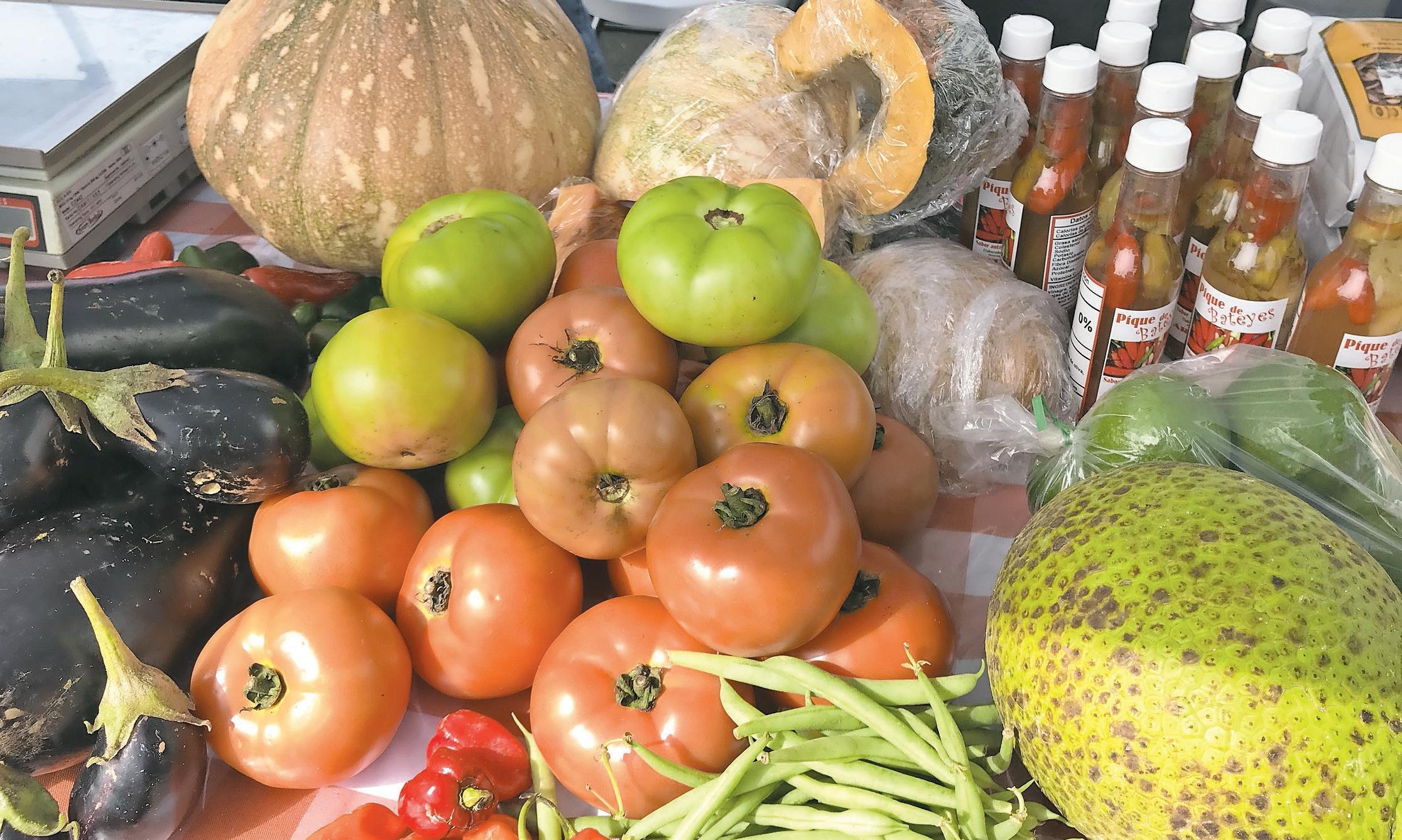
7 minute read
BUSINESS
Food production estimates for 2024 are reduced after recovery from natural disasters
Advertisement
Efraín Montalbán Ríos, The Weekly Journal
The projected increase in food production estimated by Secretary of Agriculture Ramón González, was adjusted to 40% from its initial 50% by 2024, due to the damage caused by Hurricane Fiona to the agriculture.
González informed expectations were reduced due to the shortage of agricultural staples such as plantains, bananas and eggs, a situation farmers are currently working with.
“In sectors such as plantains and bananas, which are the second largest gross income producers, we are talking about many millions of dollars [in losses]. It is a strong impact, so it will take us a year or a year and a half [to recover the crops]. We will be growing a lot next year in the egg sector and we could probably be able to make (the projection) it by the end of the term,” González said.
Since the 1980s, Puerto Rico has not been able to produce 40% of the food it consumes, according to information compiled by the College of Agricultural Sciences of the University of Puerto Rico in Mayagüez. It is estimated that only 10% of the food consumed is produced on the island, while the remaining 90% is imported by sea or air. On 2012, only 15% of the island’s total food consumption was produced.
“After Fiona hit the island, we have seen that all the farmers we have visited or talked to are on their feet and eager to recover their farms. The vast majority [of the farms] are in operation. Obviously, those growing long-term products, are still planting and waiting to harvest,” pointed González.
Personnel from the Department of Agriculture have met with more than 60 farmers from the south of Puerto Rico since last September.
“They are generally in a good mood. There will always be someone who is having specific needs and we are here to support them in whatever way is necessary,” he added.
Shortage Of Labor
As it is the case with other economic sectors, González said farmers are also facing a shortage of workers in their farms, which they have been managing with foreign labor.
“Many of them already had foreign workers. That is the problem that keeps repeating itself: labor force,” the Secretary insisted.
Puerto Rico Farmers Foundation president Vanessa Piñeiro reported that only 0.002% of the population in the Puerto Rico is dedicated to agricultural work and she stressed it is urgent to change these numbers. Piñeiro pointed out that, after the onslaught of Hurricane Fiona, all agricultural sectors are working on their recovery. Such is the case of coffee plantations, which were among the most damaged. She insisted on the importance of educating the consumer to support and buy the local products in order to increase agriculture’s economic activity. For the agronomist Abraham Rosa, there are alternatives for the agriculture sector and he recognized the efforts of farmers.
“Resilience is key, farmers need to reinvent themselves and they are doing it,” he said.
For her part, agronomist Sol Rosado warned that if the development of agricultural professionals is not prioritized, there will be no progress in Puerto Rico.
She called for greater attention to the matter because “a country without agriculture is a country that cannot progress.”
In fact,
Meanwhile, Iris Jeanette Rodríguez, owner of Since a coffee and cocoa farm in Adjuntas, assured the 1980s, Puerto that after Hurricane María, in 2017, farmers have Rico has not been come together to revive the agricultural industry able to produce and they have continued to do so after other 40% of the food it atmospheric events. consumes. “We have challenges every day. The attitude with which we face them is what makes the difference”, argued the founder of ProCafé. Regarding the Department of Agriculture’s intention to expand agricultural production on the island and reduce food imports, Piñeiro insisted that farmers are the most important part of the Puerto Rican economy and they should be a priority. “Throughout the world, agriculture is the wealth of nations. You have to recognize the importance of food at breakfast, lunch and dinner. Our challenge is for Puerto Ricans to understand that we have become a fishbowl, where they bring us food and throw it at us. The world is changing”, said Piñeiro.
Abraham Rosa, agronomist

>AP Photo/ Marcio Jose Sanchez, File
Employees in retail and customer service in high demand
Many overqualified employees hired for low-skilled positions
José Alvarado Vega, Special to The Weekly Journal
The top five job positions with the highest demand in Puerto Rico between 2020 and 2021were retail workers, cashiers, customer service reps, fast food workers and medical secretaries, according to a survey released last week by the Puerto Rico Labor and Human
Resources Department (PRLHRD). Nearly a third of employers surveyed (30.1%) said they needed to fill job positions as of March 2021, with the survey’s vacancy rate – defined as the number of available jobs over total employment – standing at 10%.
Almost 90 percent of consulted business owners with vacant positions said they were confronting difficulties in hiring employees for these jobs. Also, almost half of newly hired employees in Puerto
Rico during the period were overqualified for their jobs, as employers ramped up hiring with the phasing out of the
Covid-19 pandemic lockdowns. The over-qualification rate – the percentage of newly recruited employees with an education level higher than that required by the job position to be filled – was 42.6%, according to the PRLHRD’s Skills and Occupations in Highest Demand survey, which consulted 4,000 island establishments and covered the period between April 2020 and March 2021. The survey indicates that the industries with the highest rate of newly hired overqualified employees during the period included information (85.4%), lodging and food services (74.7%), and transportation and warehousing (60.2%). It must be noted that 28.9% of the newly hired employees were not required to have any specific education level, although 34.2% of these employees had a high school diploma or its equivalent, while 22.5% had a bachelor’s degree. Nearly half of the employers surveyed, or 43%, said they recruited at least one employee during the 2020-2021 period. The recruitment rate (percentage of all employees who were newly hired) was 3.9% during the period ending in March of last year – almost twice the 2.2% recruitment rate for the same period ending in March 2020, according to the employer survey. Employers surveyed said the jobs that were most difficult to fill were employees involving preparation of food, fast-food counter clerks and managers, sales clerks, customer service representatives, janitors and cleaning employees, agricultural workers, dental assistants, and automobile mechanics, among others. More than half (55.7%) of newly recruited employees between April 2020 and March 2021 were women, which exceeded the proportion of women in the island’s population of 53%.
Jobs in Demand
In fact, the survey indicated that newly hired employees in greatest demand during the period were retail sellers, cashiers, customer service representatives, fast-food workers and medical secretaries. These jobs paid an average of between $8.67 per hour and $10.70 per hour, according to the employer survey. Federal minimum wage is $7.25 per hour, while the hourly minimum wage in Puerto Rico is $8.50. Currently, 30 states and Washington D.C. have minimum wages above the federal minimum. Newly recruited workers who were required to have at least a bachelor’s degree and were in greatest demand during the period included graduate nurses – who received an hourly average of $17.16 – and executive secretaries and assistants – who received an average salary of $16.17 per hour. Few of these employers offered fringe benefits to the newly hired workers, with just 19.7% of those surveyed in 2021 offering health insurance, 13.3% offering productivity bonuses, and only 11.9% offering retirement plans. The survey’s separation rate –the percentage of all employees who were separated from their jobs, whether by dismissal, layoff, resignation, retirement or death – came out to 2.6% during the period ending in March 2021, which was almost
In fact, half of the 4.2% rate for the previous period. Moreover, the partial employment rate, or the percentage of employees who worked less than 28 The highest rate of newly hired overqualified employees included information (85.4%), lodging and food services (74.7%), and transportation and warehousing (60.2%). hours a week, stood at 13.7%, which represents a decrease of 4.6 percentage points when compared to the previous period rate of 18.3 percent. Regarding required job skills, over 60 percent of newly hired employees between 2020 and 2021 were required to know how to use computers and have a mastery of specific programs, according to the study. The most required tasks or activities employers required of the new workers, expressed as a percentage of employers, included fulfilling scheduled plans (77.7%); talking to clients (71.7%), working in a group or team (67.9%); managing assigned priorities (63%) and mastering basic arithmetic skills (56.5%). “It will be very interesting to be able to compare this report, which corresponds to the critical pandemic period, with the one that publishes in December 2023 and which will cover the period of economic resurgence that we are living in Puerto Rico, ” PRLHRD secretary Gabriel MaldonadoGonzález said in a press release announcing the survey.



